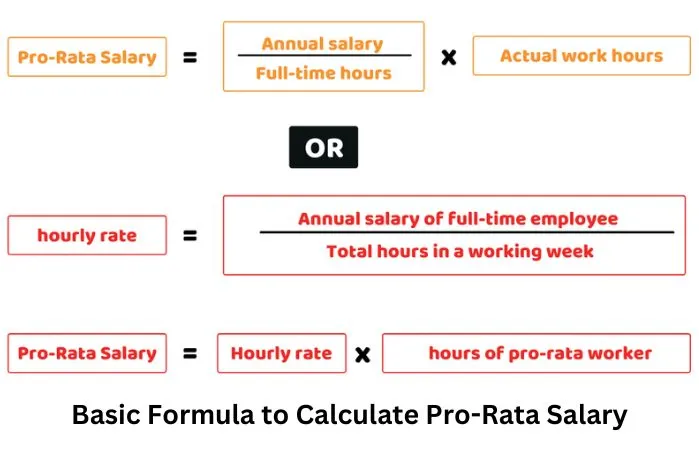How to Calculate Pro Rata Salary (Step-by-Step Guide With Example)
Whether you’re a part-time worker or joining or leaving mid-year, you must know how to calculate pro rata salary. After all, you must know exactly how much salary you’ll get for the exact amount of time you’ve worked.
Generally, pro-rata refers to the percentage or proportion that someone distributes in equal parts according to an individual’s share in the overall allocation. The process makes sure that everyone gets their fair share in the distribution.
To what end, then, do businesses utilize the term "pro rata" when determining pay for their employees? If you're unsure about what is a prorated salary, the salary offered might be misleading. In this post, we'll help you learn what pro-rata means and to calculate your pro-rata salary in a step-by-step manner.
What Is Pro Rata Salary?

A pro-rata salary is one in which the employee receives a salary proportional to the amount they’ve worked. The salary is based on an annual or monthly full-time salary, but the amount that the employer receives as a part-time salary is a proportion of the full-time salary.
To calculate pro-rata salary, the employer makes deductions according to a full-time salary when an employee works part-time. Generally, there are two types of employees in a company:
- Full-time employees
- Part-time employees
Full-time employees are paid on a fixed basis, which is a particular amount or pro-rata per annum, instead of hourly. On the other hand, part-time employees get their salaries according to the hours they've worked. Both employees are salaried employees, but part-time workers receive a pro-rata salary as compared to full-time salaried employees.
How Does Pro Rata Salary Work?
A pro-rata salary works according to the number of hours an employee has worked in proportion to what they would get if they worked full-time. This may occur when employees join a company during the pay period, or their leaves exceed the total number allowed.
For example, if an employee leaves an organization in the middle of a month, the employer will pay according to the number of hours the employee has worked. An employer uses the pro-rata salary method in the following situations:
- Someone is working as a part-time employee in a company
- A company hires personnel in the middle of the pay period or month
- A person left the company in the middle of the pay period or month
- An employee takes unpaid leaves
- An employee is working on a project for only a specific period
- In the case of promotion, when the employee's salary increases in the middle of the pay period or month
How to Calculate Pro Rata Salary?
There are different methods to calculate pro-rata salary depending on the hourly, daily, or monthly wages. Besides that, some companies also offer benefits, which also include salary. The following is a step-by-step guide to calculating pro-rata share:
- Find out your full-time annual salary.
- Next, find out the full-time hours.
- Divide the annual salary or total salary by full-time hours to get your hourly rate. Annual salary is the numerator and full-time hours are in the denominator.
- Now determine the number of hours you’ve worked.
- Multiply your hourly rate by the number of hours you’ve worked. This is the pro-rata salary.
The first formula determines the hourly rate, and then you use it to calculate the pro-rata salary. You can also use the hourly rate in fraction form and directly use it in the pro-rata salary formula:
Hourly rate: Annual Salary ÷ Full-time Hours
Pro-rata Salary: Hourly Rate X Number of hours worked
If you find this method difficult, you can also use a Pro-Rata Salary Calculator. These calculators allow you to add a few inputs to calculate the pro-rata salary. For instance, you’ll have to provide the tax code, work hours, overtime pay, tax-exempt, and dividends.
A pro-rata salary calculator also allows you to work out your national insurance, taxable income, pension contributions, and dividends. Besides that, if you’re a bondholder, you can work out the share of bonds and dividends that every bondholder gets.
Example Calculation of Pro Rata Salary

For example, a company pays $50,000 per annum pro rata if an employee works full-time for 40 hours per week. An employee working part-time for 25 hours per week will calculate their salary as follows:
Hourly rate: $50,000 ÷ 40 = 1250
Pro-rata salary: 1250 X 25 = $31,250
According to this pro-rata example, the employee is working on a part-time basis. This means that a part-time employee working 25 hours a week will get a salary of $31,250. On the other hand, a full-time employee gets $50,000 for working 40 hours a week.
How to Work Out a Pro Rata Holiday
Both part-time and full-time employees are entitled to paid annual leaves per year. However, part-time employees don’t get the full holiday entitlement.
Pro-rata holiday entitlement is the number of holidays proportional to a full-time employee's holiday entitlement.
Working out pro-rata holidays helps you estimate the exact number of holidays available to plan a vacation. Calculating pro-rata holiday is simple; you can use the same method you used to calculate pro-rata salary.
Almost all employees are entitled to 5.6 weeks of paid annual leave according to the Fair Labor Standards Act (FLSA), which includes public and bank holidays. This means a full-time employee is entitled to 28 days of annual paid leave.
To calculate a pro-rata holiday, you must determine the number of days you work per week. For instance, a part-time employee works three days a week, and a full-time employee works five days a week. This means that a part-time employee is entitled to 3/5th or 5.6 times the number of holidays that a full-time employee is entitled to.
So, a pro-rata holiday for a part-time employee working three days a week will be calculated as follows:
Pro-rata holiday: 5.6 X 28 = 16.8 days
How Do You Prorate Your Monthly Salary?
To prorate your monthly salary, you must first calculate your monthly income. You can calculate it the same way as you prorate your annual salary. Determine the number of days you've worked in a month and divide it by the number of full-working days in that month. Now multiply this amount by your monthly salary.
For example, if an employee earns $5000 per month for working 21 days per month. However, in October, he worked only 12 days instead of 21. The employee can prorate his monthly salary as follows:
Monthly prorated salary: (12 ÷ 21) X $5,000
Monthly prorated salary: 0.571 X $5,000 = $2,857.14
Besides this, you can also use a pro-rata calculator monthly for calculating pro-rata salary and holidays.
FAQs
Do you get benefits when you work on a pro-rata basis?
Yes, you get benefits when you work on a pro-rata basis. Just like full-time employees, part-time employees are also entitled to the same benefits. But the employment benefits are proportionate according to the number of hours or days they've worked.
For example, if a full-time employee is entitled to 4 weeks of sick leave, a part-time employee who works half the number of days as a full-time employee is entitled to 2 weeks of sick leave.
What is the formula for the salary pay period?
A salary pay period is a schedule or pay cycle that tells how often an employee will get their salary in the working period. The salary pay period can be weekly, bi-weekly, semi-monthly, or monthly. There are employers who also pay on a daily rate basis. To calculate the annual salary for the weekly salary pay period, use this formula:
Annual salary: Gross pay X Number of pay periods per year
The gross pay is the amount before tax deductions, and the number of pay periods is when you receive the payment. For example, if an employee earns a $2,000 weekly wage, the annual income will be $2,000 X 52 = $104,000.
What is the basic salary calculation?
The basic salary calculation depends on the salary pay period. Whether you are paid according to weekly hours or monthly, you can use that information to calculate your monthly or annual salary. For example, if you get an annual salary of $50,000 and you want to calculate your basic monthly salary, you can use this formula:
Monthly salary: Annual salary ÷ 12
Monthly salary: $60,000 ÷ 12 = $5,000
How do you calculate an annual pro-rata salary?
You can calculate your annual pro-rata salary using this formula:
Annual Pro-rata Salary: Hourly Rate X Number of hours worked
The hourly rate is the full-time annual salary divided by the full-time work hours.
Is hiring part-time right for your business?
Hiring full-time or part-time depends on your business needs. Part-time hiring reduces overhead costs and gives more flexibility to employees. However, if you want more consistency and for your employees to spend more time on your work, then hiring full-time is a good option.
Final Thoughts on How to Work Out Pro Rata Salary
Calculating pro-rata salaries or holiday entitlement can be confusing, but it is very important to work them out. Especially if you're a part-time worker, you should have the right information to check if you get the right amount as a salary.
In this post, we helped you calculate pro-rata salary and also answered some common questions that part-time employees or employers encounter.
Kristen Larson is a payroll specialist with over 10 years of experience in the field. She received her Bachelor's degree in Business Administration from the University of Minnesota. Kristen has dedicated her career to helping organizations effectively manage their payroll processes with Real Check Stubs.

